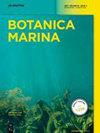Unforeseen green tide of floating tubular Ulva meridionalis, a lethal threat to oyster farming, along the west coast of Taiwan: tracking its origin and ecophysiological insights
IF 1.4
4区 生物学
Q2 MARINE & FRESHWATER BIOLOGY
引用次数: 0
Abstract
对台湾西海岸牡蛎养殖业构成致命威胁的漂浮管状莼菜不可预见的绿潮:追踪其起源和生态生理学启示
莼菜绿潮对沿海生态系统造成了不利影响。据当地农民报告,2023 年 6 月,台湾彰化县出现了前所未有的浮游管状莼菜藻华,覆盖了约 30 公里的海岸线,导致牡蛎减产约 30%。了解其分类学和生态学基础对于采取预防和补救措施至关重要。根据分子(rbcL 和 tufA)和形态学证据,U lva meridionalis 是造成此次绿潮的原因。单倍型网络分析(基于 ITS)表明,此次绿潮是通过中国沿海洋流从中国北部发源的。历史调查数据表明,U. meridionalis早在2018年就到达了桃园藻礁(藻华区以北约150公里)。我们的生态生理学实验发现,在较低盐度和类似春季的条件下,U. meridionalis在富含营养物质的当地水域中表现出快速的日生长速度,生物量增量高达13-21%。尽管历史生态和家禽/家畜数据分析显示,过去十年中海面温度和降雨量没有明显变化,但农业氮和磷的产量却逐渐增加。这一分类学和生态学背景为长期生态监测奠定了基础。此外,本研究还体现了不可预见的石莼大量繁殖对牡蛎养殖的不利影响。
本文章由计算机程序翻译,如有差异,请以英文原文为准。
求助全文
约1分钟内获得全文
求助全文
来源期刊

Botanica Marina
生物-海洋与淡水生物学
CiteScore
4.10
自引率
4.50%
发文量
43
期刊介绍:
Botanica Marina publishes high-quality contributions from all of the disciplines of marine botany at all levels of biological organisation from subcellular to ecosystem: chemistry and applications, genomics, physiology and ecology, phylogeny and biogeography. Research involving global or interdisciplinary interest is especially welcome. Applied science papers are appreciated, particularly when they illustrate the application of emerging conceptual issues or promote developing technologies. The journal invites state-of-the art reviews dealing with recent developments in marine botany.
 求助内容:
求助内容: 应助结果提醒方式:
应助结果提醒方式:


